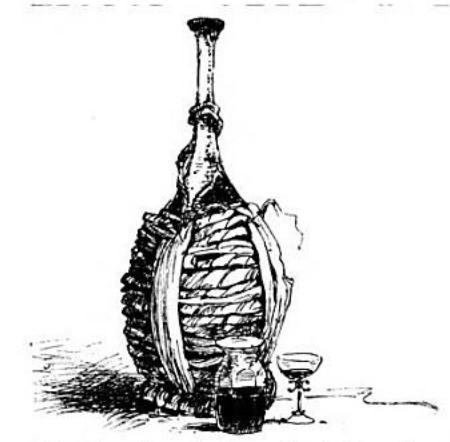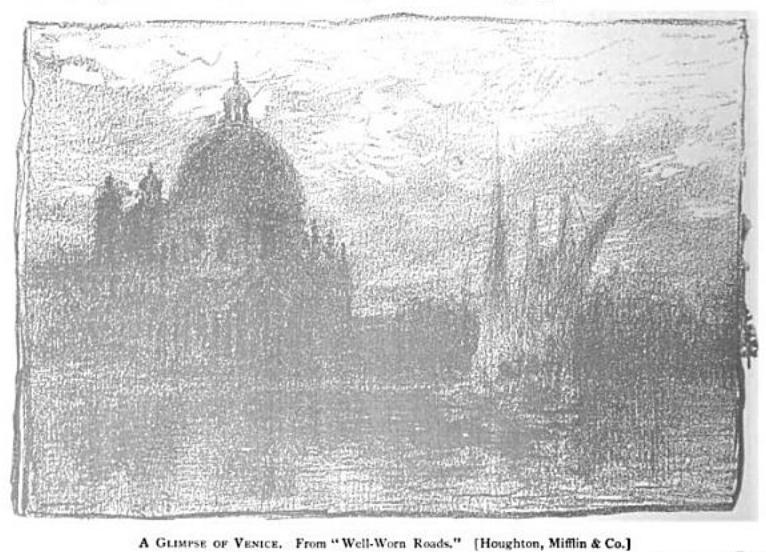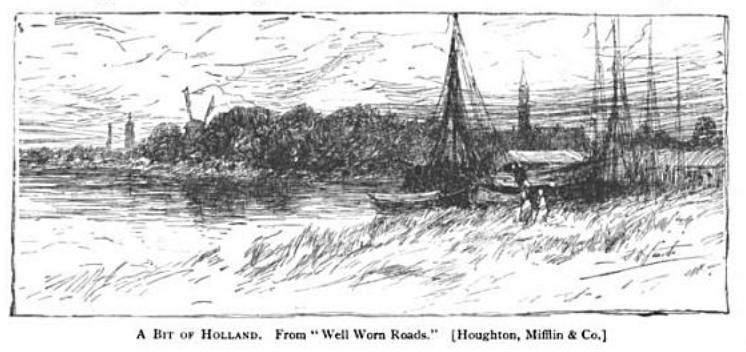Contents: Uncollected Essays
An Artist's Search for
the Picturesque.
Sarah Orne Jewett.
A review of Well-Worn Roads by F. Hopkinson Smith
in The Book Buyer 3,2 (1 December 1886), 437-439.
Sarah Orne Jewett.
A review of Well-Worn Roads by F. Hopkinson Smith
in The Book Buyer 3,2 (1 December 1886), 437-439.
Here is ideal book-making brought to fortunate realization, a writer of stories is able to illustrate them with charming pictures, and to design his own book cover. The artist's sure hand, quick eye and good taste show themselves everywhere in Mr. Hopkinson Smith's "Well-Worn Roads,"* which is certainly one of the handsomest and most companionable books of the new year. It is eminently suggestive of Christmas. There is a kind of generosity in its size and excellence, yet after reading it through delightedly, the only fault one can find is that it cannot be carried about in one's pocket. The gabled roofs and the canals of Holland, the dome of the Salute and the palaces of Venice, with groups of fishing boats, the Moorish arches and brilliant sunshine of Spain; all these are familiar enough, yet they are reproduced for us here in such a manner as to leave out the conventional aspect of things. They suddenly awaken many reminiscences; they are as different from the usual pictures of Venice, for example, as a live flower is different from a pressed one; the subtle link that makes a likeness truly part of the thing itself is not broken here. It is not only Mr. Hopkinson Smith's clever choice of subject, or his accuracy of detail, especially in the recognition of shadows and reflections, but his most sympathetic reading between the lines of the brush, of the sentiment of the place he sees and paints. Some of the smaller sketches are delightful examples of his power of suggestiveness: the flask of Chianti with two old Venetian glasses, even the Amsterdam cab; but perhaps most of all, on page 57, the high-peaked sails of the fruit-boats, like birds' wings ready for flight, seen against the anchored, immovable dome of the Salute.


The larger illustrations are full of bright colors, especially those of Spain and Venice. The heat and light of summer weather are made very evident. This is the first time that the Lewis process (known best to the public through the reproduction of Mr. Vedder's "Omar Khayyam" illustrations), has been used in reproducing watercolors, and the result is surprisingly good. But whatever praise can be given to the beauty and suggestiveness of the pictures of "Well-Worn Roads," the text is even better. Such charming short sketches have not been printed for many a day, with their delicate characterization and touches of humor and true pathos. It was a pretty idea to give the reader a glimpse of the circumstances under which each of the pictures was painted, and one presses forward in spirit to the front of every elbowing crowd that gathers to look over the artist's shoulder. May we long remember the touching incident of that sad little gray nun who stood guard over the beleaguered easel, and revealed a renounced acquaintance with the use of rose-madder! There is a great temptation to give a hint of the charm of each story; the dramatic legal proceedings about the gondola-top; the gondolier and his little lame daughter; the gypsy dance, and the cab-studio in Amsterdam; but many readers, if they are wise, will discover for themselves the author's unconscious betrayals of his good fellowship and knowledge of human nature.
Sarah O. Jewett.

Editor's Notes
Santa Maria della Salute: "(English: Saint Mary of Health), commonly known simply as the Salute, is a Roman Catholic church and minor basilica located in the Dorsoduro sestiere of the Italian city of Venice." (Wikipedia)
Rubaiyat of Omar Khayyam, The Astronomer-Poet of Persia Rendered into English Verse by Edward FitzGerald with an Accompaniment of Drawings by Elihu Vedder
A description of this book from a bookseller's advertisement: "Houghton, Mifflin and Company (Bernard Quaritch, London), Boston, 1884. Hard Cover.... Illustrated by Elihu Vedder (illustrator). First Edition Thus. 1. Photo-lithograph plates (56) With ornamental Title-page and 56 magnificent full-page Illustrations by Elihu Vedder, reproduced by the Lewis phototype process. Printed at the Riverside Press, Cambridge, Massachusetts. Medium brown flat-weave cloth over beveled boards; front cover with gilt-ruled borders, symbolist design of vase, vine, swirl and stars, and titling 'Rubaiyat of Omar Khayyam' and 'Drawings by Elihu Vedder'; rear cover without decoration; spine with gilt-ruled borders, floral ornaments, and titling 'Rubaiyat of Omar Khayyam'; illustrator's facsimile signature, gilt, on front cover, lower right "V."; grey coated endpapers with grapevine decoration; [also issued uniform in grey]. t.e.g. Detailed collation: 2 Frontis; 3 Title; 6 Pictorial Imprint; 7 Pictorial dedication; 10 Pictorial Fly-title; 11-103 Text of Third Edition; 106 Pictorial Note; 107-111 Notes, within ornamental border; 114-122 Appendix: - Omar Khayyam (by FitzGerald); 123-126 Notes on the Text; 127 List of Illustrations (56). [Potter 201][Morris & Levin 92]. From the moment of its publication, Elihu Vedder's Rubáiyát of Omar Khayyám achieved unparalleled success. The first edition appeared in Boston on 8 November 1884; six days later, it was sold out. Critics rushed to acclaim it as a masterwork of American art, and Vedder (1836 - 1923) as the master American artist. [Smithsonian American Art Museum]."
Lewis process: A review of The Mahogany Tree by W. M. Thackery in the New York Tribune for Thursday 12 December 1886, p. 6, describes the Lewis phototype process: "a modification of the albertype, in which the gelatine of the plate is made harder with a view to stronger contrasts in the printing." Further information is welcome.
Rose Madder: "The commercial name sometimes used to designate a paint made from the pigment Madder Lake -- a traditional lake pigment, extracted from the common madder plant Rubia tinctorum." (Wikipedia)
Edited by Terry Heller, Coe College.
Main Contents & Search
Contents: Uncollected Essays